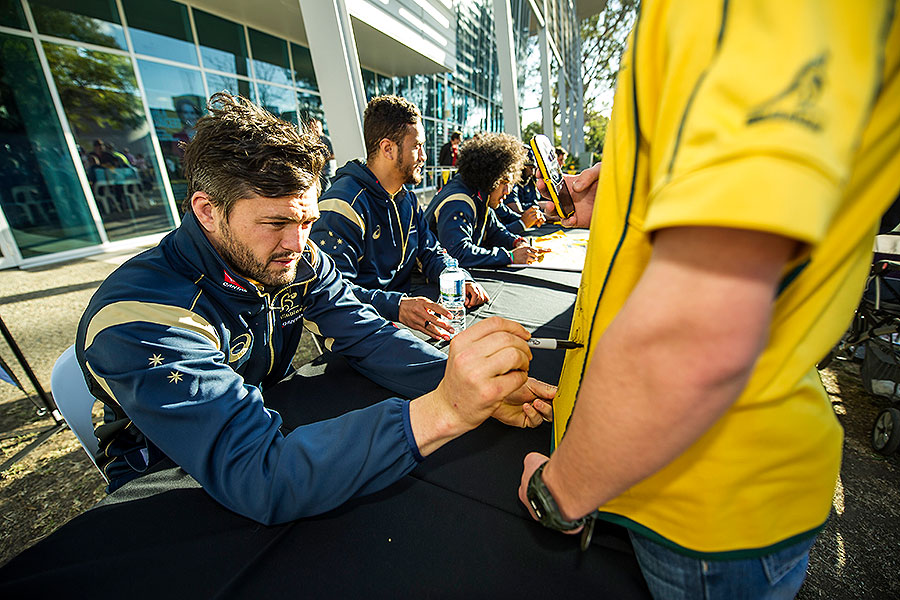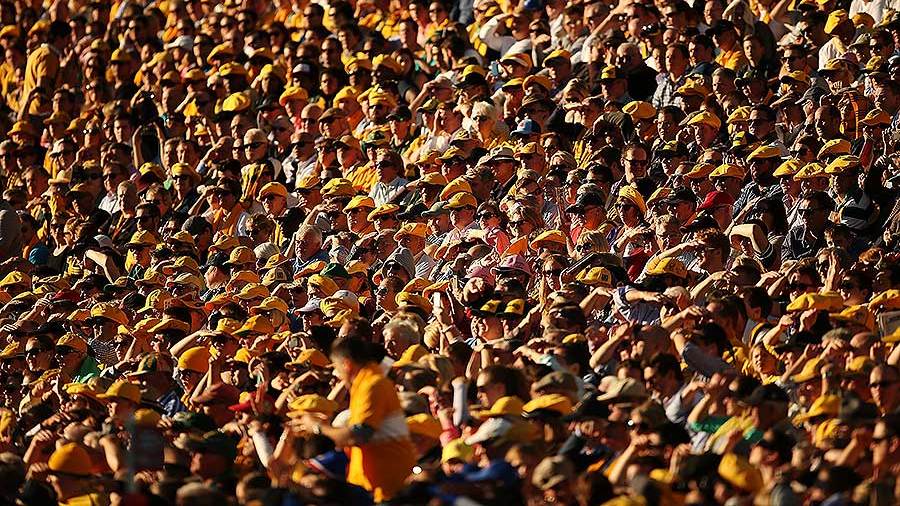|
The Growden Report
Wallabies kindle fans' pride in national colours
Greg Growden
August 11, 2014

Wallabies fans are showing their colours in a resurgence of interest in rugby in Australia © Getty Images
Enlarge
The distinctive smell of mothballs irritating your nostrils again is a sure sign that Australian rugby is getting back on track; the true gauge that the Wallabies are again winning over the mainstream is when the national jersey is on show, and bottom drawers, attics, storage units are being attacked as diehards and bandwagoners go in search of their old jumpers to boldly wear in public. When the Wallabies won titles of note you would see the jumper everywhere. It would bob up all over the place, in the strangest of spots around the globe, in all its different designs; even the absolutely shocking pyjama dog's vomit patterns the players were forced to endure during the late 1990s. For so many Australian backpackers on overseas treks, it was for years the preferred daily dress. But in recent times, the jersey as a street fashion has disappeared. This is understandable considering the dreadful slide the Wallabies have suffered in the past decade, in particular when confronting the All Blacks. Winning only five of your past 30 Bledisloe Cup encounters does lead to a debilitating inferiority complex. For the sake of avoiding public embarrassment, the jersey was buried away in those bottom drawers. But the rise of New South Wales Waratahs this season, a Super Rugby grand final triumph over a formidable New Zealand team, and the fact that the Wallabies haven't lost since early November last year, has provided some hope the serious part of this year's international calendar may actually include some joy. And with it, a reappearance of the green-and-gold garb. 
Australian rugby fans have re-connected with the Wallabies under Ewen McKenzie © Getty Images
Enlarge
This has coincided with a Wallabies campaign to reconnect with their oft-forgotten fans, including their most loyal - the bush brigade. The past week the Wallabies have been on a meet and greet tour of the New South Wales country areas - including Dubbo, Orange and Bathurst. This was a wise move, considering those in the city who control the game have often forgotten the country area, which has produced an abundance of Wallabies. As the days of the long international tours by the All Blacks, Springboks and co, which included numerous midweek matches held in the bush, have long gone, the country region has little connection with the big names these days. Not surprisingly the Central West trip was a rousing success, attracting big crowds wherever the Wallabies appeared. This was also a chance for the team to be reminded of their grassroots and the traditions of the game. It was pleasing that the trip included Orange, as this was the home of one of the most resourceful and dedicated of Australia's Test captains . Unlike the modern player, Larry Dwyer, who captained the Wallabies just over a century ago, knew nothing of luxuries. The son of poor Irish immigrants, for some years he could not afford football boots, instead using his school shoes during matches. Unable to buy a football, he borrowed some from his local club, the Orange Waratahs, and headed off to a nearby paddock to teach himself how to kick with both feet. He left school at 12 to work as a clerk in a solicitor's office; whenever selected for New South Wales or Australia, he would have to take leave from his Orange employers, who permitted him to work late on Friday night, before catching the overnight mail train to Sydney. Upon arrival at Central Station, he would trudge up the hill to the Sydney Cricket Ground, introduce himself to his team-mates, play the Test or state game and then head straight back to the railway station for the return trip to Orange so he could be back in time to start work on Monday morning. Such resolve saw him captain Australia on their 1913 tour of New Zealand, where the local experts rated him as one of the finest fullbacks they had seen - especially after he led the tourists to a surprise 16-5 victory over the All Blacks in Christchurch. In their book The Visitors, R.H Chester and N.A.C McMillan wrote that Dwyer following that win was included "among the great Australian fullbacks for his ability to kick the ball the length of the field, his uncanny handling skills, his prowess at punching holes in the defence and his deadly tackling". His other feats included being an Australian handball champion. Through such crucial 'Bush to Bledisloe' tours, the legacy of Dwyer and co, and their pride in the national colours, thankfully lives on.
Wallabies coach Ewen McKenzie has spoken exclusively to ESPNscrum. Listen to the full, frank and wide-ranging interview on ESPNscrum from Tuesday, August 12, to get an insight into the Wallabies coach's thoughts and methods ahead of the first Bledisloe Cup Test in Sydney on Saturday, August 16.
© ESPN Sports Media Ltd
|
Live Sports
Communication error please reload the page.
-
Football
-
Cricket
-
Rugby
-
- Days
- Hrs
- Mins
- Secs
F1 - Abu Dhabi GP
Abu Dhabi Grand Prix December 11-131. Max Verstappen ()
2. Valtteri Bottas (Mercedes)
3. Lewis Hamilton (Mercedes)
4. Alexander Albon ()
5. Lando Norris ()
6. Carlos Sainz Jr ()
-
ESPNOtherLive >>
Snooker - China Open
Tennis - Miami Open

